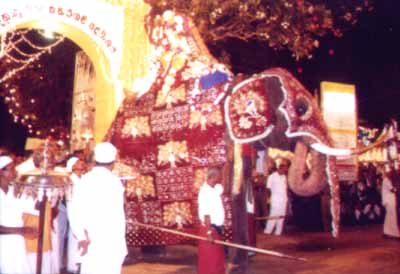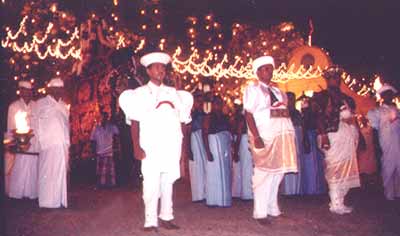 
God of War heals Sri Lankans after conflict

|
|
In a grand royal procession recalling the god's epithet as Kataragama Divya Rājōttama ('Divine King of Kings'), the Kataragama God (above) and His entourage of officials and servants (below) pay a stately visit to Valli Amma every evening of the fortnight-long festival.
|

|
|
|
|
The Kataragama God pays a short visit to his sweetheart Valli at Valli Amma Devale
|
|
|
|
Daytime fire walking at Kataragama
|
Colombo: The Sunday Leader, 4 August 1996
by Chamath Ariyadasa
KATARAGAMA, Sunday (Reuters) - Peace means Kataragama, Sri Lanka's
six-headed God of War, is busier than ever.
Drawn by Kataragama's supposed unending power to grant wishes, the
devoted walked on burning embers and bathed in a holy river in a
centuries-old religious festival that drew throngs of pilgrims to this
small town.
Hindus, Buddhists, Muslims and Christians alike are captivated by the
God of War in normal times, but the country's relative peace this year
meant a larger-than-ever turnout at the annual festival.
The recent 16-day gathering to please the sometimes angry god is also
helping heal wounds as Hindu Tamils and Buddhist Sinhalese mingle and pray
together, said those who attended. "I am visiting Kataragama after 36
years," said M.S. Mylvaganam, a 66-year-old Tamil tea plantation
worker.
"My daughters were scared to travel during the war. Now we feel
it's safer," said Mylvaganam, who lives in the central hill region.
Sarath Kumara, a 20-year-old Sinhalese from drought-hit southern
Moneragala said his wish was for a permanent end to war. "I wish for
peace as it will help us all," he said. A Norwegian-brokered
ceasefire has silenced the guns since February 2002, and brought the
government and the LTTE to the negotiating table after 20 years of war.
Pilgrims stood quietly in a queue to walk barefoot over scorching hot sand
before smashing coconuts, lighting incense and making offerings to
colourfully painted idols of deities.
Children with shaven heads bathed in a holy river and babies were
carried under the bellies of elephants for good luck.
Devotees believe acts of self-flagellation win favour with the God of
War, and some clad in loincloths rolled in the scalding sand around the
temple.
Others skewered their cheeks and tongues with tiny spears or suspended
themselves by small hooks pierced into their backs.
Men, women and even children walked barefoot over a bed of burning
embers to the cries of "Haro Hara" (Praise the Lord). Kataragama,
sits amid dry scrubland adjoining a wildlife park.
The city has long been considered holy, but for decades was accessible
only through thick jungle.Now, Sri Lankans mostly arrive in trucks or
vans, sometimes extended families of up to 30 people from a single
village.
Nilanga Dela, chief trustee of the Buddhist temple at Kataragama, said
more than a half a million people poured into the city this year, calmed
by the ceasefire that has opened up roads to the Hindu-populated and
war-torn North-East.
"Kataragama brings the different communities together. That is why
it is important," he said. Some still make the traditional walk to
Kataragama, winding down the coast from homes in the North, a journey of
up to 500 km (300 miles) that can take more than a month to cover.
"We came walking. I can still manage it," said 65-year-old
Selliah, smiling and thumping his legs, while resting on a mat along with
members of his village. At sunrise, many pilgrims bathe in the river
before making their way to a shrine complex that includes a temple for
Buddhists and a mosque for Muslims.
At night, troupes of spectacularly dressed dancers, parade around the
temples to the sound of pipes, conch shells, flutes and drums, while
ornately clad elephants are led by their mahouts.
Some dancers twirl burning sticks over their heads, and others carry
arched frames called "kavadi" that are brought from their
villages.
A few tourists mingled in the crowds. "We were advised that this
was an important place to visit.
I am very impressed," said M. Shanmugarajah from Malaysia.
Courtesy: Reuters News Alert of 31 August 2003. This article also appeared in The Daily News (Colombo) of Monday, 1 September 2003.
| 
